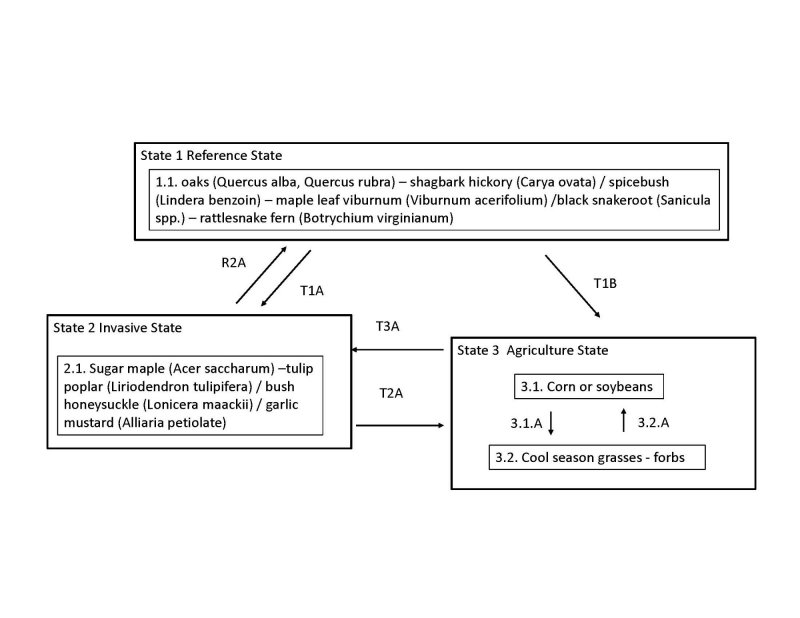
Natural Resources
Conservation Service
Ecological site F114XA103IN
Sloping Lacustrine Forest
Last updated: 9/26/2024
Accessed: 11/23/2024
General information
Provisional. A provisional ecological site description has undergone quality control and quality assurance review. It contains a working state and transition model and enough information to identify the ecological site.
MLRA notes
Major Land Resource Area (MLRA): 114X–Southern Illinois and Indiana Thin Loess and Till Plain
MLRA 114A makes up about 4,550 square miles (11,795 square kilometers). The three parts of this MRLA are mostly in the Till Plains Section of the Central Lowland Province of the Interior Plains. The western third of the western part is in the Highland Rim Section of the Interior Low Plateaus Province of the Interior Plains. The eastern half of the eastern part is in the Kanawha Section of the Appalachian Plateaus Province of the Appalachian Highlands. Both large and small tributaries of the Ohio River dissect the nearly level to very steep glaciated uplands in this area. The major streams and rivers have well defined valleys with broad flood plains and numerous stream terraces. The flood plains along the smaller streams are narrow. Broad summits are nearly level to gently sloping. Elevation ranges from 320 feet (100 meters) on the southernmost flood plain along the Ohio River to 1,250 feet (380 meters) on the highest ridges. Local relief is mainly 10 to 50 feet (3 to 15 meters), but it can be 50 to 100 feet (15 to 30 meters) along drainageways and streams. Also, the Ohio River bluffs are as much as 300 feet (90 meters) above the river valley floor.
Classification relationships
222 Eastern Broadleaf Forest (Continental) Province.
Bluegrass Natural Region of Indiana. Homoya's Natural Regions of Indiana.
The following NatureServe Explorer Ecological community has a high level of probability to match the ecological site reference community found on these soils. Field work is required for verification and conformation.
Quercus rubra - (Acer saccharum, Quercus alba) Forest
Translated Name: Northern Red Oak - (Sugar Maple, White Oak) Forest
Common Name: Red Oak - Sugar Maple - Elm Forest
Unique Identifier: CEGL005017
Ecological site concept
Historically, Sloping Lacustrine Forest sites were mature, high-quality, upland deciduous forests. Soils in this groups area generally formed in lacustrine parent materials and are moderately well drain to well drained. Sites occur on glacial lake plains, moraines, or high stream terraces often with slope or on a convex surface.
High quality reference site species include northern red oak, white oak, American beech, sugar maple, tulip polar, shagbark hickory, bitternut hickory, white ash, American elm, black walnut, basswood, black gum, and sassafras. Mid-canopy species may include flowering dogwood (Cornus florida), hophornbeam (Ostrya virginiana), and red maple (Acer rubrum). Shrubs include spicebush (Lindera benzoin) and mapleleaf viburnum (Viburnum acerifolium L.). Without disturbance, the understory community will be dense, with rich diversity, and numerous spring ephemerals.
On many sites, the dominant canopy trees are now American beech, sugar maple, and/or tulip poplar as oaks have historically been removed. Associate species may include basswood, white ash, yellow buckeye, hornbeam, and hop-hornbeam. On mature sites, a dense tree canopy will form a thick layer of ground-level humus and leaf litter. Understory plants will vary depending on available sunlight. Without post-harvest management, these sites will transition after large-scale disturbances from an oak-mixed hardwood forest to a post-disturbance maple-beech-poplar forest.
Associated sites
| F114XA102IN |
Lacustrine Terrace Forest Lacustrine Terrace Forest. Soils in this group are predominately somewhat poorly drained and have lower slopes. |
|---|
Similar sites
| F114XA102IN |
Lacustrine Terrace Forest Lacustrine Terrace Forest. These sites share some similar species but have lower slopes. |
|---|
Table 1. Dominant plant species
| Tree |
(1) Quercus |
|---|---|
| Shrub |
(1) Lindera benzoin |
| Herbaceous |
(1) Sanicula |
Click on box and path labels to scroll to the respective text.
| T1A | - | Non-native species invade site; no control efforts |
|---|---|---|
| T1B | - | Clearing of site; tillage; seeding; weed control; agricultural management |
| R2A | - | Brush and weed control; timber stand improvement activities |
| T2A | - | Clearing of trees and shrubs; site preparation; tillage; seeding; weed control |
| T3A | - | Site abandoned. No management inputs. |
State 1 submodel, plant communities
State 2 submodel, plant communities
State 3 submodel, plant communities
| 3.1A | - | Site preparation; seeding; weed control; grassland management |
|---|---|---|
| 3.2A | - | Site preparation; tillage; seeding; weed control; row crop management |
